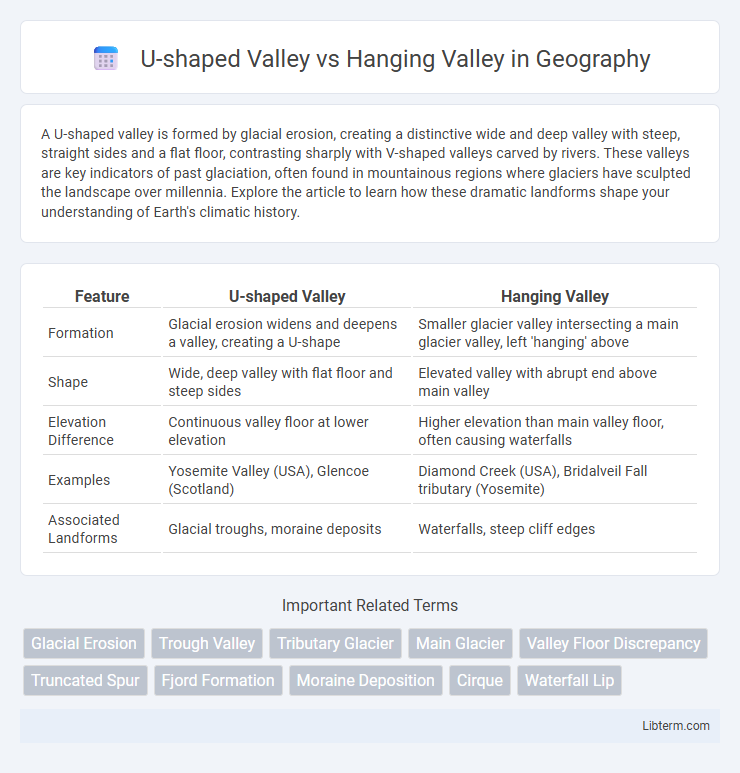A U-shaped valley is formed by glacial erosion, creating a distinctive wide and deep valley with steep, straight sides and a flat floor, contrasting sharply with V-shaped valleys carved by rivers. These valleys are key indicators of past glaciation, often found in mountainous regions where glaciers have sculpted the landscape over millennia. Explore the article to learn how these dramatic landforms shape your understanding of Earth's climatic history.
Table of Comparison
| Feature | U-shaped Valley | Hanging Valley |
|---|---|---|
| Formation | Glacial erosion widens and deepens a valley, creating a U-shape | Smaller glacier valley intersecting a main glacier valley, left 'hanging' above |
| Shape | Wide, deep valley with flat floor and steep sides | Elevated valley with abrupt end above main valley |
| Elevation Difference | Continuous valley floor at lower elevation | Higher elevation than main valley floor, often causing waterfalls |
| Examples | Yosemite Valley (USA), Glencoe (Scotland) | Diamond Creek (USA), Bridalveil Fall tributary (Yosemite) |
| Associated Landforms | Glacial troughs, moraine deposits | Waterfalls, steep cliff edges |
Introduction to U-Shaped and Hanging Valleys
U-shaped valleys are formed by the erosive action of glaciers, characterized by their distinct broad, flat floors and steep sides, typically found in mountainous regions. Hanging valleys occur where a smaller tributary glacier joins a main valley glacier, resulting in a tributary valley that is elevated above the main valley floor, often featuring waterfalls. These glacial landforms illustrate the dynamic geological processes of ice erosion and deposition during periods of glaciation.
Geological Formation Processes
U-shaped valleys form through the powerful erosive action of glaciers, carving wide, deep troughs with steep sides as ice advances and retreats over time. Hanging valleys develop when smaller tributary glaciers erode less deeply than the main glacier, leaving elevated valleys that abruptly drop into the deeper U-shaped valley below. Both formations reveal distinct glacial dynamics and stages of valley floor sculpting, showcasing varying rates of glacial erosion and sediment deposition.
Key Characteristics of U-Shaped Valleys
U-shaped valleys are characterized by their broad, deep floors and steep, straight sides formed by glacial erosion, contrasting with the narrower, shallower valleys created by river activity. These valleys often display a flat bottom and steep cliffs, resulting from the glacier's ability to erode the valley floor and walls uniformly. Unlike hanging valleys, which occur where tributary glaciers meet a main glacier and form elevated valleys that deposit waterfalls, U-shaped valleys are main valleys shaped predominantly by the movement of large glaciers.
Defining Features of Hanging Valleys
Hanging valleys are characterized by their elevated position above the main U-shaped valley floor, formed when smaller tributary glaciers join a larger glacier but do not erode the valley floor to the same depth. These valleys often feature steep cliffs or waterfalls where they intersect with the main valley, highlighting the differential glacial erosion. Unlike the broad, flat floors of U-shaped valleys, hanging valleys are narrower and perched higher, creating distinct topographical contrasts.
Differences in Valley Formation
U-shaped valleys form through the extensive glacial erosion of V-shaped river valleys, creating wide, deep troughs with steep sides by the movement of glaciers. Hanging valleys develop when smaller tributary glaciers erode their valleys less deeply than the main glacier, resulting in elevated valley floors that often create waterfalls where they meet the main valley. The primary difference in formation lies in the scale and erosive power of the glaciers, with U-shaped valleys representing major glacial troughs and hanging valleys indicating tributary valleys left "hanging" above the main valley floor.
Typical Locations and Examples
U-shaped valleys, characterized by their broad, deep troughs formed by glacial erosion, are commonly found in regions like the Swiss Alps, Yosemite National Park in California, and the fjords of Norway. Hanging valleys, created when smaller tributary glaciers join a main glacier at a higher elevation, are prominently observed in the Canadian Rockies, such as the Maligne Canyon in Jasper National Park, and the famous Bridalveil Fall in Yosemite. These distinct glacial landforms provide key insights into past glacial activity and landscape evolution across mountainous terrains worldwide.
Ecological Significance
U-shaped valleys provide critical habitats for diverse flora and fauna due to their broad, flat floors and sheltered environments, supporting rich biodiversity and water resources. Hanging valleys often create waterfalls that contribute to unique microhabitats, fostering specialized ecosystems and influencing nutrient cycling in mountainous regions. Both landforms play essential roles in maintaining ecological balance by shaping hydrology and offering varied ecological niches in alpine landscapes.
Role of Glaciers in Valley Shaping
Glaciers play a crucial role in shaping both U-shaped valleys and hanging valleys through their powerful erosive forces as they advance and retreat. U-shaped valleys form when large, dense glaciers carve wide, deep troughs with steep, straight sides and flat bottoms by grinding down the landscape over long periods. Hanging valleys develop as smaller tributary glaciers flow into the deeper main glacier, resulting in elevated valley floors that often create waterfalls where the tributary meets the main valley.
Human Activities and Valley Landscapes
Human activities such as agriculture and infrastructure development significantly impact U-shaped valleys, often leading to soil erosion and altered drainage patterns due to the valley's broad, flat floor. In contrast, hanging valleys, characterized by their elevated and steep profiles, experience limited human intervention but are popular for recreational activities like hiking and tourism, which influence local ecosystems. Both valley landscapes require careful management to preserve their unique geomorphological features and maintain sustainable land use.
Conclusion: Comparing U-Shaped and Hanging Valleys
U-shaped valleys are characterized by their broad, steep-walled profiles formed by glacial erosion, while hanging valleys are smaller tributary valleys elevated above the main valley floor due to differential glacial erosion. The distinct geomorphological features highlight the varying impacts of glacial processes on landscape evolution, with U-shaped valleys representing major glacier paths and hanging valleys indicating former tributary glaciers. Understanding these differences provides critical insights into past glacial dynamics and aids in reconstructing paleoclimatic conditions.
U-shaped Valley Infographic

 libterm.com
libterm.com